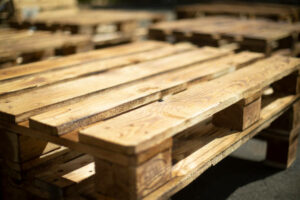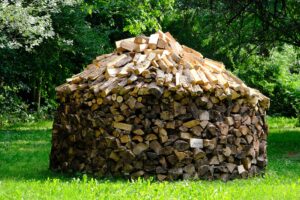Wood beams serve as fundamental components in construction, providing structural support and shaping the integrity of buildings. Understanding the various types of wood beams is crucial for architects, builders, and anyone involved in development projects. In this article, we will examine different types and applications of wood beams, shedding light on their vital role in the construction industry.
Types of Wood Beams and their applications
1. Parallam Wood Beams
Unique Insight: Parallam beams can be manufactured with curved profiles. This opens the door to creative architectural designs, allowing for unconventional shapes and adding a unique touch to your construction project. The ideal length for Parallam wood beams depends on project requirements, with lengths commonly available up to 60 feet. Consultation with a structural engineer is recommended for precise length determinations based on project specifics.
Ideal Application: Parallam wood beams, with their ability to be curved, find a sweet spot in projects demanding unconventional designs. They are best incorporated in structures where unique shapes and profiles are a priority.
2. Gluam Wood Beams (Glued Laminated Beams)
Unique Insight: Beyond their structural prowess, glued Laminated timber beams are eco-friendly. The lamination process of these wooden beams allows a structural engineer to use smaller, fast-growing trees, reducing the demand for large, mature trees and promoting sustainable forestry practices. The ideal length for Glulam wood beams varies based on specific project requirements, load-bearing considerations, and design specifications. These beams are versatile and can be manufactured in lengths exceeding 100 feet, offering flexibility for diverse applications. Consulting with a structural engineer is recommended for precise determinations based on project-specific needs.
Ideal Application: Glued laminated timber beams are perfect for expansive spaces, such as arenas, churches, or large commercial buildings. Their versatility allows for eye-catching arches and long spans, making a bold statement in modern architecture.
3. LVL Wood Beam (Laminated Veneer Lumber)
Unique Insight: Laminated Veneer lumber beams have fire-resistant qualities because of their composition and manufacturing process, LVL beams can withstand higher temperatures compared to traditional timber, adding an extra layer of safety to your construction.
Ideal Application: LVL wooden beam is considered the workhorse of residential construction. They excel in floor and roof framing, providing reliable support. Veneers are used in residential projects for interiors where quality, stability, and cost-effectiveness are paramount.
4. Solid Wood Beams
Some architects opt for reclaimed solid wood beams, not just for their aesthetic charm but also for the history they carry. Each beam may have a story to tell, having weathered time and events before finding a new purpose in your construction project.
Ideal Application: Solid timber beams are used in visible structural elements like exposed ceiling beams or decorative trusses in houses. They are used in spaces where the need for natural wood is a focal point.
5. Engineered Wood Beams
Unique Insight: Engineered wood beams often include a web made from oriented strand board (OSB). The OSB web not only contributes to the beam’s strength but also makes use of wood scraps and residuals, minimizing waste in the manufacturing process.
Ideal Application: They are used for residential and light commercial projects with ease. Engineered wood I-beams are your go-to for floors and roof framing. Their versatility and strength make them a staple in modern buildings.
6. Box Wood Beams
Unique Insight: Box beams can be hollow, making them ideal for concealing utilities such as wiring or plumbing. This integration of form and function adds a practical dimension to the aesthetic appeal of box beams in modern development.
Ideal Application: Box beams shine in spaces where utility concealment is crucial. They are installed in areas where you want a clean aesthetic while accommodating wiring, plumbing pipes, or other decorative purposes for your house.
7. Timber Frame Wood Beams
Unique Insight: Timber frame has a notable environmental benefit which includes, that wood captures and stores carbon dioxide during its growth, and when used in a structure. It continues to store carbon, contributing to the reduction of greenhouse gas emissions.
Ideal Application: Timber frame beams are a natural fit in homes or structures aiming for a cozy, cabin-like feel. Ideal for a residential house, they create an inviting atmosphere with their robust and timeless presence.
8. Reclaimed Wood Beams
Unique Insight: Reclaimed wood beams may need to be treated with innovative methods, such as non-toxic borate solutions, to ensure they are free from pests and pathogens.
Ideal Application: They are a poetic choice for spaces that demand a narrative. They can be used in historical renovations, boutique hotels, or eclectic homes, where each beam carries a piece of the past.
9. Composite Wood Beams
Unique Insight: In some composite beams, recycled materials like plastic and metal are combined with wood Fibers, this not only enhances the structural properties but also gives a second life to materials that might otherwise end up in landfills.
Ideal Application: Composite beams shine in structures requiring superior strength and load-bearing capabilities, these include bridges, high-rise buildings, or industrial facilities where performance is non-negotiable.
10. Bamboo Beams
Unique Insight: Bamboo, often used in beams, is not a wood but a grass. It is one of the fastest-growing plants on the planet, making it a sustainable and rapidly renewable resource for quality and durable use.
Ideal Application: Bamboo beams find their place in eco-friendly buildings. Use them in residential or commercial spaces where sustainability is a priority, contributing to greener and more responsible building practices.
Conclusion
Choosing the right wood beam goes beyond structural considerations; it is about aligning the material with the specific needs and aesthetics of your project. From solid timber in residential spaces to the use of glulam beams in large structures, each type has a unique role to play. So, as you embark on your development journey, let the intended use of these beams guide your decisions, ensuring not just functionality but a harmonious blend of form and purpose. Craft your construction masterpiece with excellence, where every beam tells a story and contributes to the symphony of strength and beauty in your structure.






